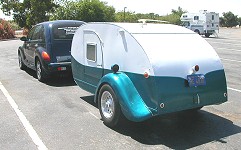Ive got very little experience with my metal squirt gun, but Ive tried to educate myself as much as I can to prevent falling into some newb traps while fabricating my trailer frame.
Some tips I found useful..
All welds will cause some sort of distortion. As the weld cools it shrinks and pulls the pieces, as if the weld is a hinge, towards the side the weld is on. It is an impressively powerful force. On small parts with small welds it doesn't tend to be very noticeable, but when using long pieces like rails for a trailer frame this can pull the whole thing out of whack permanently if not caught and remedied early enough in the build.
There are many techniques to combat this. A few basic ones:
-Clamping and bracing to hold things in place is step one toward reducing distortion. Tack welds can help hold in areas where clamping just isn't possible.
-Weld small areas at a time then move on to the opposite side. This can help to lock the piece in place before too much movement can happen and balance out the forces better.
-Limit weld size to only what is reasonably needed. If a few 1" welds will hold for the max expected force with enough overhead, then doing a whole 12" long weld really isn't gaining much besides a bunch of extra distortion.
It is tempting for us newbs to weld all around the perimeter of a joint to be sure it is as strong as possible.. But, for the typical thickness of material trailers use this can be detrimental... Concentrating too much stress in a small area. Welds are brittle compared to the surrounding metal. This can lead to cracking; compromising the strength of the frame depending on the orientation of the weld. This is one of those cases where less can be more.
Welds across a frame member are not ideal. Do what you can to orient welds running lengthwise with a main frame member. If you must weld across, then limit the weld to only the bead length needed and stay away from the edge of the frame member so it does not seed a crack at the edge.
Plug welds can be useful to tie flat sections together. My frame was originally a harbor freight kit that I redesigned for a 5x10 trailer. The kit is primarily compromised of two slightly different size cold rolled C-channels. One can fit inside the other. On a few joints I ran them both in the same orientation "spooning" if you will, and welded the top and bottom edges (the tips of the C), but there would have been no other surface to weld besides the end cuts.. which I didn't want to do. So before hand I drilled some half inch holes on the back flat of the smaller C channel. That way I could weld into the flat of the outer piece. Circles being less prone to forming cracks. The outer C channel is also slightly thicker, hence drilling the holes in the thinner material which naturally would aim the gun (and more heat) into the thicker metal.

In hindsight, even this may have been overkill.
If there is anything I'm way off base on. Let me know. Im definitely still learning, and don't want to steer others astray.










